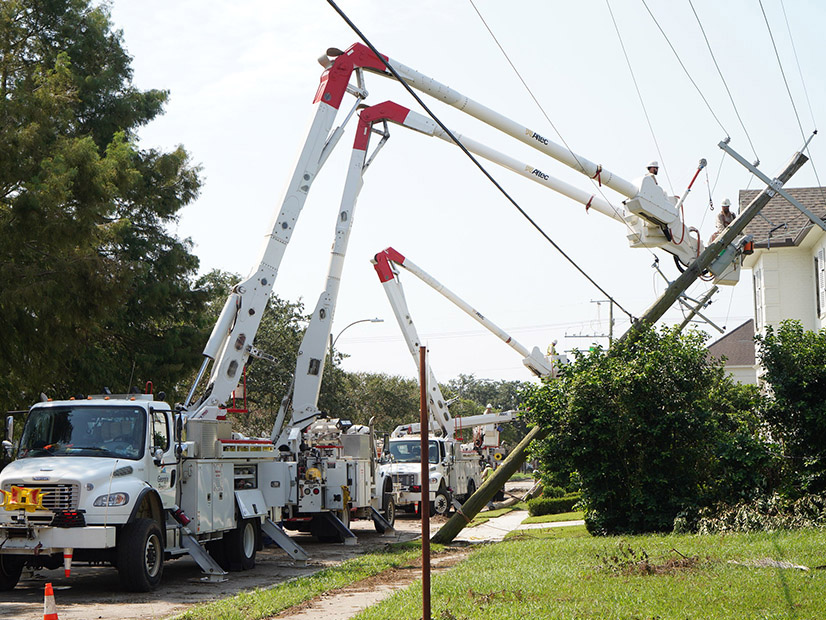
Entergy’s New Orleans division unveiled a plan Tuesday aimed at hardening the bulk electric system in preparation for future storms in the city.
The proposal comes in light of the “increased frequency and severity” of extreme weather events that are causing “greater costs and disruptions” to electric customers on the Gulf Coast, the utility said.
In the proposal, submitted to the New Orleans City Council last week, Entergy (NYSE:ETR) identified nearly 900 projects across its distribution and transmission systems that would have a beneficial resilience effect. The planned upgrades would affect more than 33,000 structures and almost 650 line-miles and would cost almost $1.3 billion over the next 10 years.
Entergy’s filing repeatedly referenced the devastation wrought last year by Hurricane Ida, which struck the Gulf Coast in August and caused more than 1.2 million electricity customers across eight states to lose power, according to the Energy Information Administration. Nearly a million of those customers were in Louisiana, including a complete blackout of Greater New Orleans after a “catastrophic transmission failure” cut all eight transmission corridors into the city. (See Entergy Investigations Certain to Follow Hurricane Ida Restoration.)
Council Ordered Resilience Plan
Following the storm, the city council ordered Entergy to submit a “system resiliency and storm hardening plan” detailing how it would prevent future natural disasters from causing such severe impacts. The council’s resolution also referenced the high costs to Entergy’s ratepayers associated with repairing storm damage; this was a frequent cause of complaint among city officials in the weeks after Ida, who also asked why previous Entergy projects that were supposed to improve resilience seemed to have no effect in practice. (See New Orleans Seeks FERC Inquiry into Entergy Planning Practices.)
In its filing, Entergy avoided these adversarial characterizations, painting itself as a partner in suffering from recent storms’ destructive powers, and an ally to the city council in attempting to alleviate their impacts on the people of New Orleans.
“Over the last five years, major hurricanes have become more frequent and intense, and slower and wetter, further increasing the potential for devastation,” Entergy said. “Additionally, coastal erosion caused by severe storms, among other things, has increased the vulnerability of New Orleans by removing an important wetlands buffer. In short, the increasingly frequent threat of severe weather poses an existential threat to the region, including New Orleans.”
The grid hardening projects identified by Entergy include 184 “rebuild projects” in the distribution feeder category, which involve the “evaluation and potential rebuilding or replacement of every asset in the protection zone to bring such assets up to the company’s current design standards.” Another 674 rebuild candidates were found among distribution laterals, while the utility also noted 30 potential overhead line burial projects.
Among the distribution projects is a feeder rebuild in Algiers, involving the hardening of 324 structures along nearly four line-miles. Another is an overhead-to-underground project involving a third of a mile of line in the Treme/Lafitte area, affecting 611 customers.
Entergy also noted two transmission rebuild projects that would “have positive benefit to cost ratios and fall within the optimized budget.” These are the Front Street to Michoud 230-kV line, which would provide “an additional connection to the eastern interconnect … that allows for additional flexibility to operate during and after a major event.” The other project is the Gulf Outlet to Air Products 69-kV line, which would replace several structures along about a mile of transmission line.
Cost Recovery Rider Proposed
To pay for the proposed upgrades, Entergy proposed a cost recovery rider to “provide a stable, long-term recovery mechanism that could be used over the 10-year period of the projects.” The rider — dubbed the “Resiliency Rider” by Entergy — is patterned on the Purchased Power and Capacity Acquisition Cost Recovery Rider and the Securitized Storm Cost Recovery Rider, which Entergy used to recover its investment in the Union Power Block 1 and the Hurricane Isaac storm restoration, respectively.
Perhaps anticipating further complaints about passing along the costs of resilience investments to customers, the utility noted that credit ratings agencies downgraded Entergy New Orleans “several times” after Hurricane Ida, with further downgrades a possibility “if financial pressures are not mitigated and system resiliency is not enhanced.” Entergy argued that accomplishing the latter without alleviating the former may not be possible with the resources currently available.
“Credit ratings directly affect [Entergy’s] cost of capital investment and overall customer rates,” Entergy said. “Without timely and efficient cost recovery for the projects presented herein, [Entergy’s] financial health likely would be further compromised given the amount of the expenditures involved over an extended period.”
Entergy executives sought to position the proposal as a proactive measure to upgrade and modernize the grid ahead of future storms, while attempting to soften expectations by pointing out that “no amount of infrastructure investment can make an electric system completely resistant to the impacts of extreme weather conditions.” In a press release Deanna Rodriguez, CEO of Entergy New Orleans, said the utility expects to work with the city council to finalize the project list and its financial backing.
“While investments to harden the grid carry a significant cost, they result in substantial customer benefits in the long run,” Rodriguez said. “Robust investments in grid resiliency will reduce the duration of power outages following major storms and will also reduce future storm restoration costs. Our objective is two-fold: the hardening of the New Orleans grid and how quickly we get power back on for customers.”


